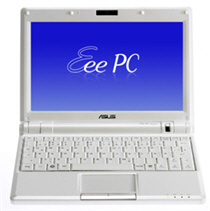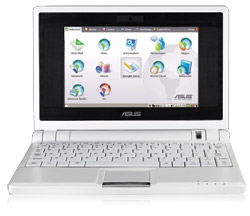After a lot of dilly-dallying, I finally pulled the trigger on the Asus EEE PC 1000H. As I mentioned on my comparison, it seemed to me that it is the best of the current crop of netbooks.
The Asus EEE PC 1000H is definitely bigger than your typical netbook. But it brings with it a bigger display, keyboard (majorly sucky wrongly-placed itsy bitsy right shift key), and battery. Although these lead to less portability, these definitely improved usability and coupled with the bigger memory and disk space brings it up almost to the level of ultraportable notebooks but without the hefty price tag. The sleek black case even reminds me of the Fujitsu P7020 that I was lusting for a long time ago.
It booted up straight out of the box and, with the input of some personalization and localization information, was almost ready for use.
The wired network worked fine. It let me get my wireless network’s security details which I then keyed in, unplugged the network cable and I was wireless in a snap.
The 80gb hard disk provides a comfortable amount of space but is partitioned in two. Not very flexible. So merged the two with the freely downloadable EASEUS Partition Manager. As with most netbooks (and some ultraportables), there is no built-in optical drive. So I had to use my USB to SATA/IDE adapter to copy my backup files from my external drive and install software from their CD installers.
And that was it. It seemed snappy with Firefox 3.0, Yahoo! Messenger, Open Office 3.0 beta 2, and Eclipse. Movies and music played smoothly with VLC. I’ll also be running Tomcat and MySQL servers but maybe after a 1Gb memory upgrade.
 The Asus EEE PC 900 has been shown by Asus at CeBIT 2008. It’s got the same small and cute form factor as the originals but now has an 8.9″ screen, 1GB or RAM, and 12GB SSD. Those are exactly what I’ve been waiting for! Time to start saving up.
The Asus EEE PC 900 has been shown by Asus at CeBIT 2008. It’s got the same small and cute form factor as the originals but now has an 8.9″ screen, 1GB or RAM, and 12GB SSD. Those are exactly what I’ve been waiting for! Time to start saving up. Yesterday, as I was heading out for lunch, I encountered Tessa at the elevator lobby. She was carrying this small black neoprene case that almost without a doubt contained an electronic gadget. From the dimensions, I concluded that it was an Asus Eee which I’ve heard and read quite a bit about. But to be sure, I asked her and she confirmed that it is indeed an Eee. We talked about it a bit but since lunch was waiting, I scheduled a visit with her for later in the afternoon. As soon as I got some free time, I went up to her office and played around with the Eee.
Yesterday, as I was heading out for lunch, I encountered Tessa at the elevator lobby. She was carrying this small black neoprene case that almost without a doubt contained an electronic gadget. From the dimensions, I concluded that it was an Asus Eee which I’ve heard and read quite a bit about. But to be sure, I asked her and she confirmed that it is indeed an Eee. We talked about it a bit but since lunch was waiting, I scheduled a visit with her for later in the afternoon. As soon as I got some free time, I went up to her office and played around with the Eee.